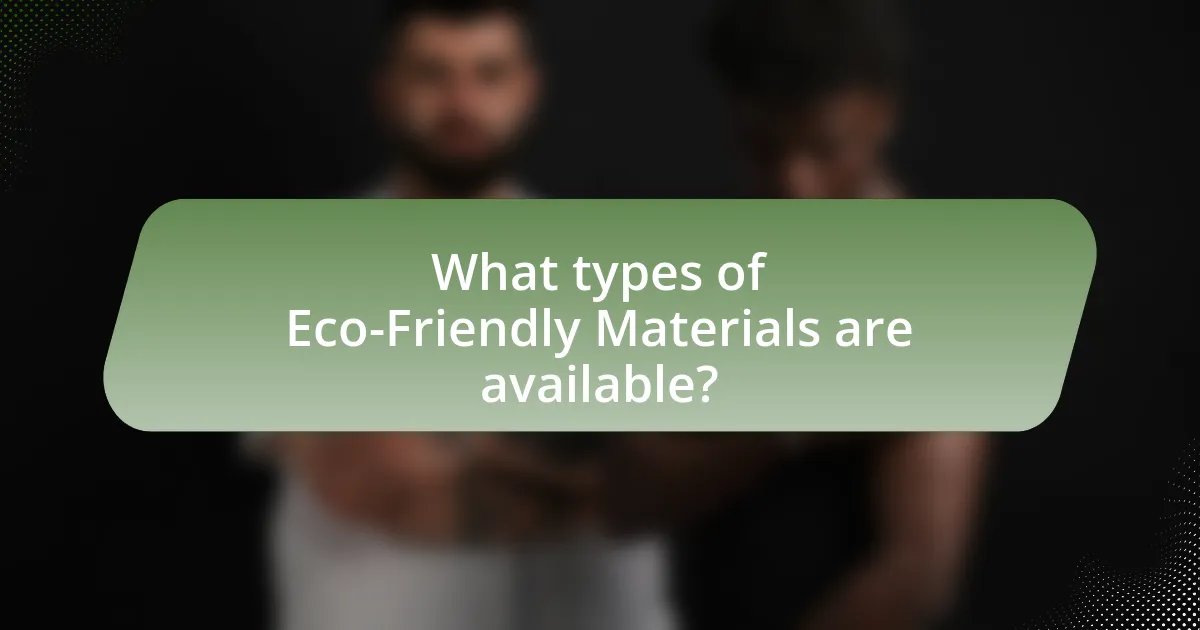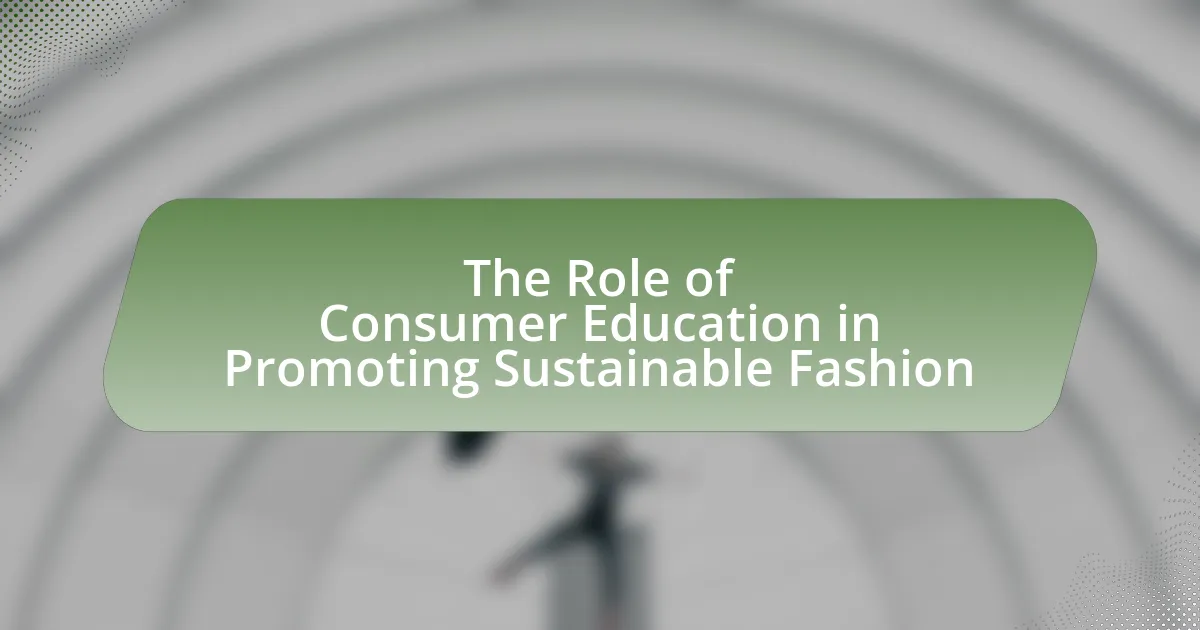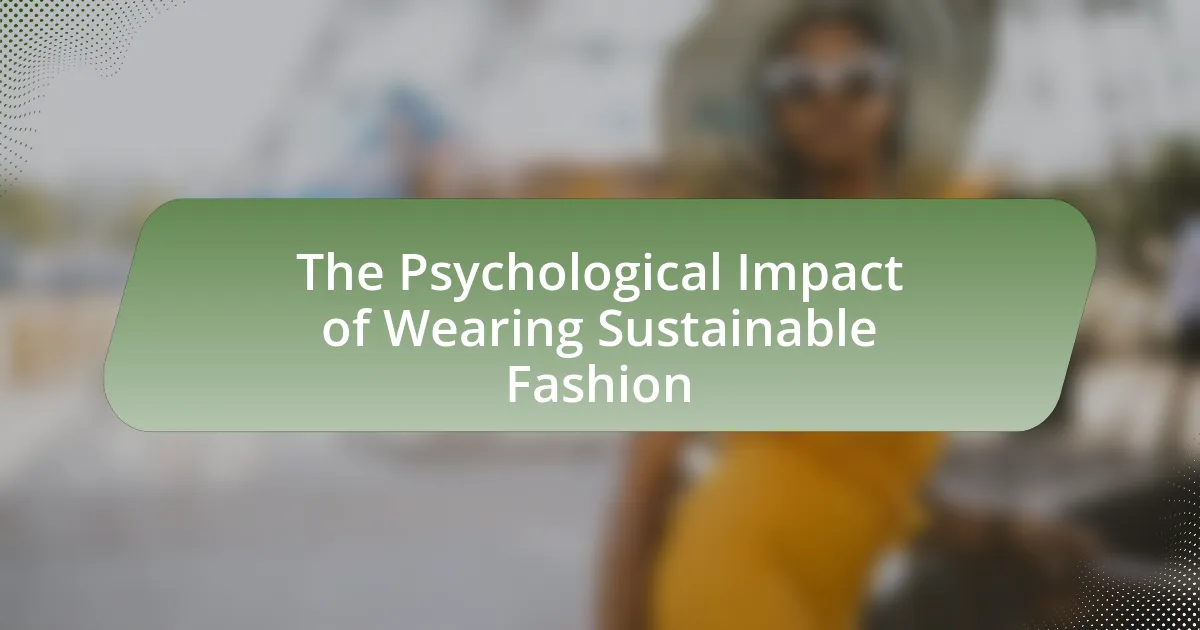Innovative fabrics in fashion design are materials that integrate advanced technology and sustainable practices to improve functionality, aesthetics, and environmental impact. This article explores the differences between innovative and traditional fabrics, highlighting characteristics such as moisture-wicking, breathability, and biodegradability. It also examines the importance of fabric choice in fashion design, the role of eco-friendly materials in promoting sustainability, and the environmental impacts of conventional fabrics. Additionally, the article discusses popular eco-friendly fabrics, the challenges designers face in adopting these materials, and strategies for overcoming these barriers, ultimately emphasizing the future of innovative fabrics in the fashion industry.

What are Innovative Fabrics in Fashion Design?
Innovative fabrics in fashion design refer to materials that incorporate advanced technology or sustainable practices to enhance functionality, aesthetics, and environmental impact. These fabrics often include features such as moisture-wicking, breathability, and biodegradability, which cater to modern consumer demands for performance and sustainability. For instance, fabrics made from recycled plastics or organic fibers demonstrate a commitment to reducing waste and environmental harm, aligning with the growing trend towards eco-friendly fashion.
How do Innovative Fabrics differ from traditional materials?
Innovative fabrics differ from traditional materials primarily in their functionality and environmental impact. While traditional fabrics like cotton and polyester focus on basic properties such as durability and comfort, innovative fabrics often incorporate advanced technologies that enhance performance, such as moisture-wicking, temperature regulation, and antimicrobial properties. For instance, fabrics made from recycled plastics not only reduce waste but also offer similar or superior performance compared to conventional materials. Additionally, many innovative fabrics are designed to be biodegradable or produced through sustainable processes, addressing the environmental concerns associated with traditional textile manufacturing. This shift towards eco-friendly materials reflects a growing trend in the fashion industry to prioritize sustainability alongside functionality.
What characteristics define Innovative Fabrics?
Innovative fabrics are defined by their sustainability, functionality, and advanced technology. These materials often incorporate eco-friendly components, such as organic fibers or recycled materials, which reduce environmental impact. Additionally, they may feature properties like moisture-wicking, breathability, and durability, enhancing performance in various applications. For instance, fabrics like Tencel, made from sustainably sourced wood pulp, exemplify both eco-friendliness and superior comfort. Furthermore, innovative fabrics often utilize smart technology, such as temperature regulation or embedded sensors, to improve user experience. This combination of sustainability, functionality, and technological advancement characterizes the evolution of textiles in the fashion industry.
Why is the choice of fabric important in fashion design?
The choice of fabric is crucial in fashion design because it directly influences the garment’s aesthetic, functionality, and sustainability. Different fabrics possess unique properties such as texture, drape, and breathability, which affect how a design is perceived and worn. For instance, natural fibers like organic cotton and linen are not only biodegradable but also offer comfort and breathability, aligning with the growing demand for eco-friendly materials in the fashion industry. Additionally, the choice of fabric can impact the environmental footprint of a garment; for example, using recycled polyester can significantly reduce waste and resource consumption compared to conventional materials. Thus, selecting the right fabric is essential for creating designs that are visually appealing, practical, and environmentally responsible.
What role do Eco-Friendly Materials play in fashion?
Eco-friendly materials play a crucial role in fashion by reducing environmental impact and promoting sustainability. These materials, such as organic cotton, hemp, and recycled polyester, help minimize waste and lower carbon emissions during production. For instance, organic cotton uses 91% less water than conventional cotton, significantly conserving water resources. Additionally, the use of recycled polyester can divert plastic waste from landfills, with estimates suggesting that recycling one ton of plastic can save up to 5,774 kWh of energy. By integrating eco-friendly materials, the fashion industry can shift towards more responsible practices, addressing consumer demand for sustainable products while contributing to environmental conservation.
How do Eco-Friendly Materials contribute to sustainability?
Eco-friendly materials contribute to sustainability by reducing environmental impact through their production, use, and disposal. These materials, such as organic cotton, recycled polyester, and bamboo, are sourced from renewable resources and often require less energy and water compared to conventional materials. For instance, organic cotton uses 91% less water than traditional cotton farming, significantly lowering water consumption in the textile industry. Additionally, eco-friendly materials often biodegrade more easily, minimizing landfill waste and pollution. The use of such materials in fashion design not only promotes sustainable practices but also encourages a circular economy, where products are reused and recycled, further enhancing sustainability efforts.
What are the environmental impacts of conventional fabrics?
Conventional fabrics have significant environmental impacts, primarily due to their production processes, resource consumption, and waste generation. The cultivation of natural fibers like cotton requires extensive water usage, with estimates indicating that it takes about 7,000 liters of water to produce just one kilogram of cotton. Additionally, synthetic fabrics, such as polyester, are derived from petroleum, contributing to fossil fuel depletion and greenhouse gas emissions during their production.
Moreover, the dyeing and finishing processes of conventional fabrics often involve toxic chemicals that can contaminate water sources, harming aquatic ecosystems. According to the World Bank, textile dyeing is responsible for 20% of global water pollution. Furthermore, the disposal of conventional fabrics in landfills contributes to significant waste, as many synthetic fibers do not biodegrade, persisting in the environment for hundreds of years. These factors collectively highlight the detrimental environmental effects associated with conventional fabric production and use.

What types of Eco-Friendly Materials are available?
Eco-friendly materials include organic cotton, hemp, bamboo, recycled polyester, and Tencel. Organic cotton is grown without synthetic pesticides or fertilizers, making it a sustainable choice for textiles. Hemp is a fast-growing plant that requires minimal water and no pesticides, providing a durable fabric option. Bamboo is biodegradable and grows quickly, offering a soft and breathable material. Recycled polyester, made from post-consumer plastic bottles, reduces waste and conserves resources. Tencel, derived from sustainably sourced wood pulp, is produced in a closed-loop process that minimizes environmental impact. These materials contribute to sustainable fashion by reducing ecological footprints and promoting responsible consumption.
What are the most popular Eco-Friendly Fabrics used today?
The most popular eco-friendly fabrics used today include organic cotton, Tencel (lyocell), hemp, and recycled polyester. Organic cotton is cultivated without synthetic pesticides or fertilizers, making it a sustainable choice for clothing. Tencel, derived from sustainably sourced wood pulp, is known for its biodegradability and low environmental impact during production. Hemp is a highly durable fabric that requires minimal water and no pesticides, contributing to its eco-friendliness. Recycled polyester, made from post-consumer plastic bottles, helps reduce waste and the demand for virgin polyester. These fabrics are increasingly favored in the fashion industry for their sustainability and reduced environmental footprint.
How is organic cotton produced and what are its benefits?
Organic cotton is produced through farming practices that avoid synthetic pesticides and fertilizers, focusing instead on natural methods to promote soil health and biodiversity. This cultivation process includes crop rotation, composting, and the use of organic seeds, which helps maintain ecological balance and reduces environmental impact. The benefits of organic cotton include reduced exposure to harmful chemicals for farmers and consumers, improved soil quality, and lower water usage compared to conventional cotton farming. Additionally, organic cotton production supports sustainable agricultural practices, contributing to the overall health of ecosystems and communities.
What makes Tencel a sustainable choice for fashion designers?
Tencel is a sustainable choice for fashion designers due to its production process, which utilizes renewable wood sources and employs a closed-loop system that recycles water and solvents. This fiber, derived from sustainably harvested eucalyptus, beech, and spruce trees, minimizes environmental impact by reducing water usage by up to 95% compared to conventional cotton. Additionally, Tencel’s biodegradability ensures that it breaks down naturally, further contributing to its eco-friendly profile. The combination of these factors makes Tencel a responsible option for designers aiming to create sustainable fashion.
How do recycled materials fit into the Eco-Friendly fabric category?
Recycled materials are integral to the Eco-Friendly fabric category as they significantly reduce waste and resource consumption. By repurposing materials such as plastic bottles, textiles, and other post-consumer products, the fashion industry minimizes the need for virgin resources, thereby lowering environmental impact. For instance, using recycled polyester can save up to 60% of the energy required to produce new polyester from petroleum. This practice not only conserves natural resources but also decreases greenhouse gas emissions associated with fabric production.
What processes are involved in recycling fabrics?
Recycling fabrics involves several key processes: collection, sorting, shredding, and reprocessing. Initially, used textiles are collected from various sources, including donation centers and recycling programs. Following collection, the fabrics are sorted based on material type, quality, and color, which is essential for determining the appropriate recycling method. After sorting, the fabrics are shredded into smaller pieces to facilitate further processing. Finally, the shredded materials undergo reprocessing, where they can be transformed into new fibers or products, such as insulation, rags, or new textiles. This multi-step approach not only reduces waste but also conserves resources, as recycling textiles can save up to 95% of the water and energy required to produce new fabrics from raw materials.
What are the advantages of using recycled polyester in fashion?
Recycled polyester offers significant advantages in fashion, primarily by reducing environmental impact and promoting sustainability. This material is derived from post-consumer plastic waste, such as bottles, which diverts waste from landfills and reduces the need for virgin polyester production. The production of recycled polyester consumes up to 59% less energy compared to traditional polyester, leading to lower greenhouse gas emissions. Additionally, using recycled polyester can help brands meet consumer demand for eco-friendly products, as studies show that 66% of global consumers are willing to pay more for sustainable brands. Thus, recycled polyester not only supports environmental conservation but also aligns with market trends favoring sustainability in fashion.

What are the challenges of using Innovative Fabrics?
The challenges of using innovative fabrics include high production costs, limited availability, and performance issues. High production costs arise from the advanced technology and materials required to create these fabrics, making them less accessible for mass production. Limited availability is often due to the niche market for eco-friendly materials, which can restrict sourcing options for designers. Performance issues may involve durability and maintenance, as some innovative fabrics may not withstand wear and tear as effectively as traditional materials. These challenges can hinder the widespread adoption of innovative fabrics in the fashion industry.
What barriers do designers face when adopting Eco-Friendly Materials?
Designers face several barriers when adopting eco-friendly materials, primarily including higher costs, limited availability, and performance issues. The higher costs associated with sustainable materials often deter designers, as these materials can be more expensive than conventional options, impacting budget constraints. Limited availability poses another challenge, as not all eco-friendly materials are widely accessible, making sourcing difficult for designers. Additionally, performance issues, such as durability and functionality, can arise with some sustainable materials, leading designers to question their viability for specific applications. These barriers collectively hinder the widespread adoption of eco-friendly materials in fashion design.
How do cost and availability affect the use of Innovative Fabrics?
Cost and availability significantly influence the adoption of innovative fabrics in fashion design. High costs can limit the accessibility of these materials for designers and manufacturers, leading to reduced usage in mainstream fashion. For instance, eco-friendly fabrics often require advanced technology and sustainable sourcing, which can drive up prices. Additionally, limited availability of these materials can hinder production scalability, making it challenging for brands to incorporate them into their collections. According to a report by the Textile Exchange, the market for sustainable textiles is growing, but the high cost and inconsistent supply chain remain barriers to widespread adoption.
What are the performance concerns associated with Eco-Friendly Fabrics?
Performance concerns associated with eco-friendly fabrics include durability, moisture management, and colorfastness. Many eco-friendly materials, such as organic cotton or bamboo, may not withstand wear and tear as effectively as conventional fabrics, leading to shorter lifespans for garments. Additionally, moisture-wicking properties can be inferior in some sustainable options, affecting comfort during physical activities. Colorfastness is another issue, as natural dyes used in eco-friendly fabrics may fade more quickly than synthetic alternatives, impacting the aesthetic longevity of the product. These factors can limit the practical applications of eco-friendly fabrics in high-performance fashion contexts.
How can designers overcome these challenges?
Designers can overcome challenges in using eco-friendly materials by adopting a multi-faceted approach that includes education, collaboration, and innovation. Educating themselves about sustainable practices and materials enables designers to make informed choices that align with environmental goals. Collaborating with material scientists and sustainable manufacturers can lead to the development of innovative fabrics that meet both aesthetic and functional requirements. Additionally, utilizing technology such as 3D printing and digital design tools allows for more efficient use of resources and reduces waste. Research indicates that the global sustainable fashion market is projected to reach $8.25 billion by 2023, highlighting the increasing demand for eco-friendly solutions and the potential for designers to thrive in this evolving landscape.
What strategies can be employed to source sustainable materials?
To source sustainable materials, companies can implement strategies such as establishing partnerships with certified suppliers, utilizing recycled materials, and adopting a circular economy approach. Establishing partnerships with suppliers who hold certifications like Global Organic Textile Standard (GOTS) ensures that materials meet environmental and social criteria. Utilizing recycled materials, such as post-consumer plastics or fabric scraps, reduces waste and resource consumption; for instance, the fashion brand Patagonia uses recycled polyester derived from plastic bottles. Adopting a circular economy approach encourages the design of products that can be reused, repaired, or recycled, thereby minimizing environmental impact. These strategies collectively enhance sustainability in material sourcing within the fashion industry.
How can collaboration with suppliers enhance the use of Eco-Friendly Fabrics?
Collaboration with suppliers can significantly enhance the use of eco-friendly fabrics by facilitating access to sustainable materials and innovative production techniques. When fashion brands work closely with suppliers, they can share knowledge about sustainable practices, leading to the development of new eco-friendly textiles. For instance, suppliers can provide insights into sourcing organic fibers or recycled materials, which are essential for creating environmentally responsible products. Additionally, collaborative efforts can streamline the supply chain, reducing waste and energy consumption during production. Research indicates that companies that engage in sustainable supply chain practices can reduce their carbon footprint by up to 30%, demonstrating the tangible benefits of such collaborations.

What is the future of Innovative Fabrics in Fashion Design?
The future of innovative fabrics in fashion design is centered around sustainability, functionality, and technological integration. As consumer demand for eco-friendly materials increases, designers are increasingly adopting biodegradable, recycled, and organic fabrics. For instance, the global market for sustainable textiles is projected to reach $8.25 billion by 2025, reflecting a significant shift towards environmentally responsible practices. Additionally, advancements in smart textiles, which incorporate technology for enhanced performance, are expected to revolutionize the industry by offering features such as moisture-wicking, temperature regulation, and even health monitoring. This trend is supported by research from the Textile Research Journal, which highlights the growing importance of integrating technology with sustainable practices in fabric development.
How are technological advancements shaping Eco-Friendly Materials?
Technological advancements are significantly shaping eco-friendly materials by enabling the development of sustainable alternatives to traditional fabrics. Innovations such as bioengineering and nanotechnology have led to the creation of materials like biodegradable polyester and organic cotton blends, which reduce environmental impact. For instance, a study published in the Journal of Cleaner Production highlights that the use of recycled fibers can decrease water consumption by up to 90% compared to virgin materials. Additionally, advancements in digital printing technology minimize waste and energy use, further enhancing the sustainability of fashion production. These developments illustrate how technology is driving the shift towards more environmentally responsible materials in the fashion industry.
What innovations are emerging in fabric production?
Innovations in fabric production include the development of bio-based textiles, such as those made from algae, pineapple leaves, and recycled plastics. These materials not only reduce reliance on petroleum-based fibers but also promote sustainability in the fashion industry. For instance, companies like Ananas Anam have created Piñatex, a leather alternative derived from pineapple leaf fibers, which has gained traction for its eco-friendly properties. Additionally, advancements in digital printing technology allow for more efficient and less wasteful production processes, enabling intricate designs without the need for extensive water usage or harmful dyes. These innovations reflect a growing trend towards sustainable practices in fabric production, aligning with consumer demand for environmentally responsible fashion.
How can 3D printing contribute to sustainable fashion practices?
3D printing can significantly contribute to sustainable fashion practices by enabling on-demand production, which reduces waste associated with overproduction. This technology allows designers to create garments and accessories tailored to specific consumer needs, minimizing excess inventory and material waste. Additionally, 3D printing can utilize eco-friendly materials, such as biodegradable filaments made from plant-based sources, further decreasing the environmental impact of fashion manufacturing. According to a study published in the Journal of Cleaner Production, 3D printing can reduce material waste by up to 90% compared to traditional manufacturing methods, highlighting its potential for promoting sustainability in the fashion industry.
What trends are influencing the adoption of Eco-Friendly Fabrics?
The adoption of eco-friendly fabrics is influenced by several key trends, including increasing consumer awareness of sustainability, advancements in textile technology, and regulatory pressures for environmentally responsible practices. Consumer demand for sustainable products has surged, with a 2021 survey indicating that 66% of global consumers are willing to pay more for sustainable brands. Additionally, innovations in textile production, such as the development of biodegradable materials and recycled fibers, are making eco-friendly options more accessible and appealing. Regulatory frameworks, such as the European Union’s Green Deal, are also pushing the fashion industry towards more sustainable practices, further driving the adoption of eco-friendly fabrics.
How is consumer demand driving change in the fashion industry?
Consumer demand is driving change in the fashion industry by increasingly prioritizing sustainability and ethical practices. As consumers become more aware of environmental issues, they are actively seeking brands that utilize eco-friendly materials and transparent supply chains. For instance, a 2021 survey by McKinsey & Company found that 67% of consumers consider the use of sustainable materials important when making fashion purchases. This shift in consumer preferences has prompted brands to innovate by developing and adopting sustainable fabrics, such as organic cotton, recycled polyester, and biodegradable materials, to meet the growing demand for environmentally responsible products.
What role do fashion brands play in promoting sustainability?
Fashion brands play a crucial role in promoting sustainability by adopting eco-friendly practices and materials in their production processes. These brands are increasingly integrating sustainable fabrics, such as organic cotton, recycled polyester, and Tencel, which significantly reduce environmental impact compared to conventional materials. For instance, the use of recycled polyester can save up to 60% of energy compared to virgin polyester production, thereby lowering carbon emissions. Additionally, many fashion brands are committing to transparency in their supply chains, allowing consumers to make informed choices and encouraging industry-wide accountability. This shift not only fosters consumer awareness but also drives innovation in sustainable practices across the fashion industry.
What practical tips can designers follow to incorporate Innovative Fabrics?
Designers can incorporate innovative fabrics by researching and selecting materials that prioritize sustainability and functionality. For instance, utilizing fabrics made from recycled plastics or organic fibers can significantly reduce environmental impact while offering unique textures and properties. Additionally, collaborating with textile manufacturers who specialize in eco-friendly materials ensures access to the latest advancements in fabric technology. According to a report by the Ellen MacArthur Foundation, transitioning to circular fashion practices, including the use of innovative fabrics, can lead to a 70% reduction in greenhouse gas emissions by 2030. This evidence supports the importance of integrating sustainable materials into design processes.
How can designers effectively communicate the benefits of Eco-Friendly Materials to consumers?
Designers can effectively communicate the benefits of eco-friendly materials to consumers by utilizing clear messaging that highlights sustainability, health benefits, and environmental impact. For instance, designers can emphasize that eco-friendly materials, such as organic cotton or recycled polyester, reduce harmful chemical usage and lower carbon footprints, appealing to environmentally conscious consumers. Research indicates that 66% of global consumers are willing to pay more for sustainable brands, demonstrating a market demand for transparency in sourcing and production practices. By providing specific data on the reduced environmental impact of these materials, such as lower water usage or reduced waste, designers can build trust and encourage informed purchasing decisions.
What best practices should be followed when selecting and using Innovative Fabrics?
When selecting and using innovative fabrics, prioritize sustainability, functionality, and performance. Sustainable fabrics, such as organic cotton or recycled polyester, reduce environmental impact and promote eco-friendliness in fashion design. Functionality is crucial; fabrics should meet specific needs, such as moisture-wicking for activewear or breathability for summer clothing. Performance characteristics, including durability and ease of care, enhance the longevity and usability of garments.
Research indicates that the global market for sustainable textiles is projected to reach $8.25 billion by 2027, highlighting the increasing demand for eco-friendly materials (Grand View Research, 2020). Additionally, using innovative fabrics can lead to reduced waste and lower carbon footprints, aligning with the growing consumer preference for environmentally responsible products.




